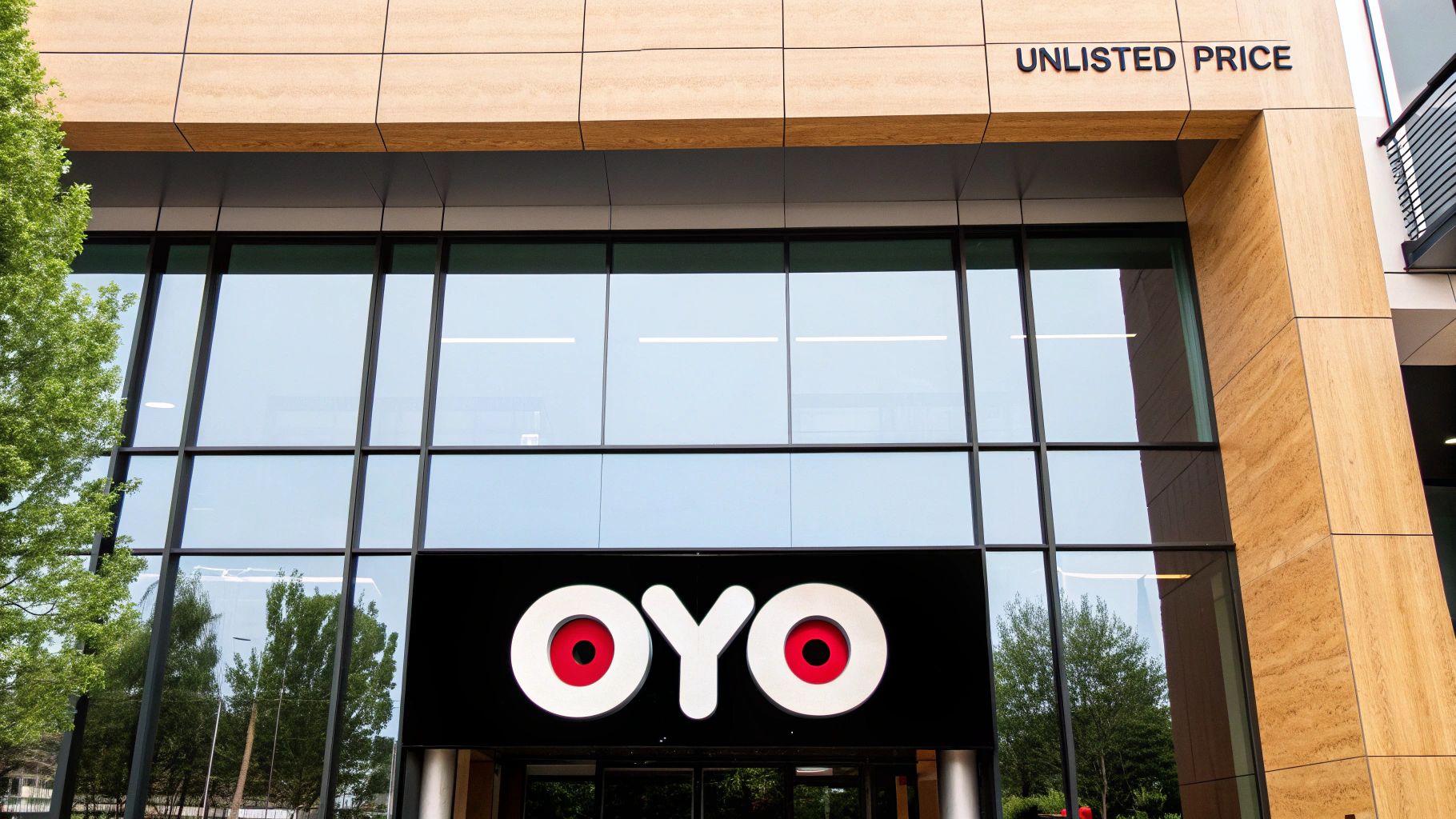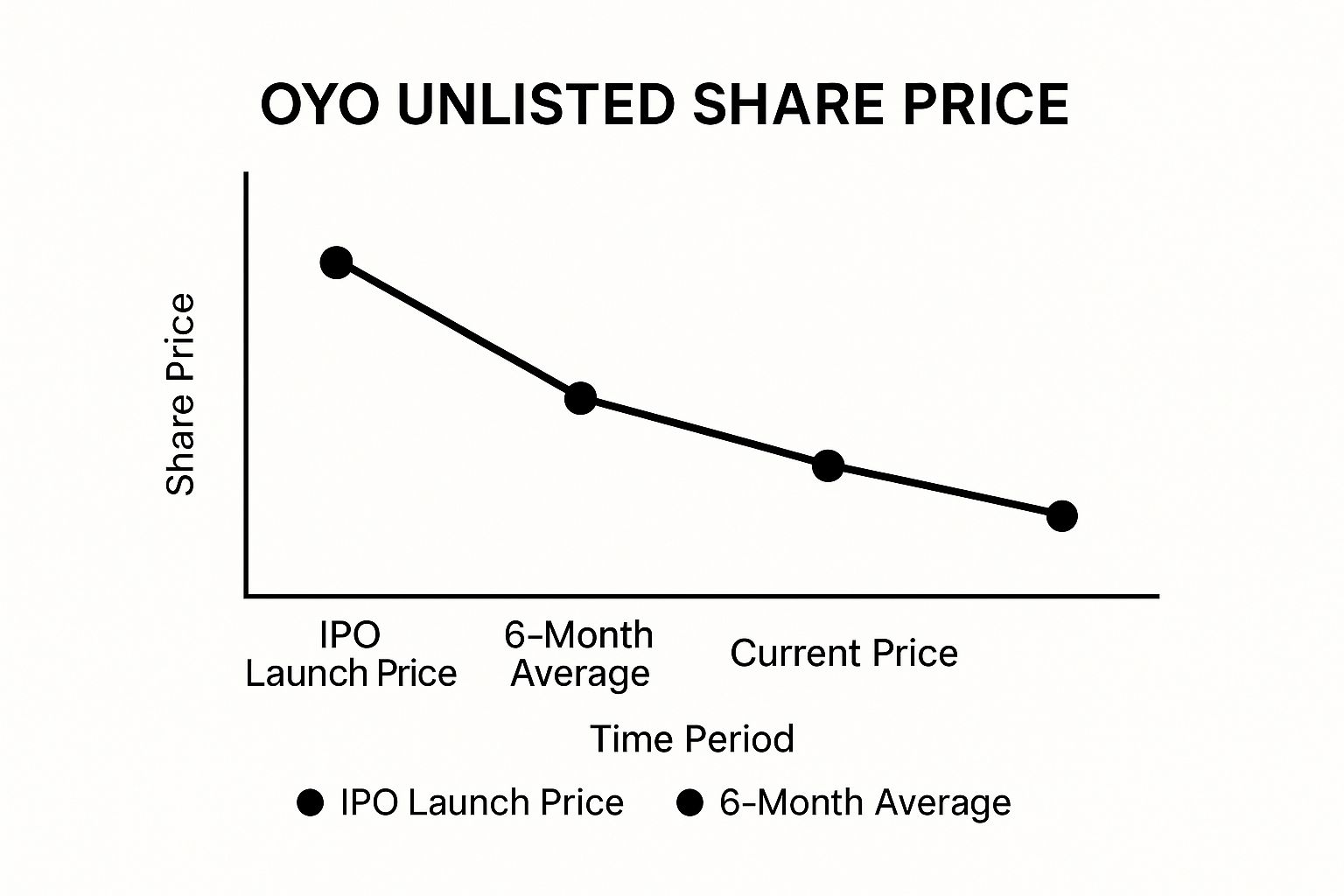
Figuring out the OYO unlisted share price isn't straightforward; it involves interpreting activity within India's dynamic grey market. Unlike shares traded on public exchanges like the National Stock Exchange (NSE) or BSE Limited (BSE), the value of pre-IPO companies such as OYO (Oravel Stays Limited) is less defined. Prices often emerge from direct negotiations between buyers and sellers or via specialized platforms, resulting in noticeable price differences.
These price fluctuations aren't arbitrary but stem from various influences. Positive developments can increase demand and prices. Examples include:
The unlisted market's structure often leads to significant price swings for OYO shares. Oravel Stays Limited, for example, has seen considerable fluctuations in India's pre-IPO space.
In the 52 weeks leading up to March 2024, the OYO unlisted share price moved between ₹35 and ₹140. This substantial ₹105 difference translates to a 300% swing, showing the market's activity level and associated risk.
Furthermore, estimates of OYO's market capitalization differ greatly depending on the source. Figures range from ₹32,500 crore to ₹39,686 crore, calculated using different share prices like ₹53 or ₹60 per share. This highlights the lack of transparency in unlisted share pricing, where valuations depend on limited transaction data and varied calculation approaches. Discover more insights about OYO's valuation journey on Planify
Seasoned investors monitor these OYO unlisted share price changes carefully. They aim to separate genuine shifts in company value from market speculation or short-term noise.
Investors look for patterns in trading volumes, examine the gap between buying and selling prices across platforms, and connect price movements to specific company news or industry trends. A sharp price increase might signal rising confidence, possibly linked to IPO rumors or strong financial performance.
However, such increases could also result from limited share availability meeting temporary high demand. Understanding these dynamics is key to making sound investment decisions rather than just reacting to price changes. It requires assessing whether the current price reflects the company's underlying strength or just prevailing market mood.

While the fluctuating OYO unlisted share price often captures attention in the grey market, understanding the company's actual worth means looking much deeper. Professional investors and analysts use specific Valuation Methodologies to estimate OYO's fundamental value, frequently arriving at figures quite different from the daily trading prices seen on various platforms. These methods aim to analyze the core business health and future potential, cutting through market noise.
Traditional valuation models like discounted cash flow (DCF) present challenges for high-growth tech firms like OYO, particularly given its history of prioritizing expansion over immediate profits. Consequently, analysts often rely on comparative analysis, measuring OYO against similar global hospitality tech companies, both public and private. They also evaluate precedent transactions, like past funding rounds, though these reflect specific historical moments and investor sentiment at that time.
Several core factors significantly shape how experts assess OYO's potential value, going beyond the day-to-day share price fluctuations:
It's crucial to understand that different investor types evaluate OYO's worth using distinct perspectives. Venture capital (VC) and private equity (PE) firms typically concentrate on long-term potential, the ability to disrupt markets, and possible exit strategies like an IPO or acquisition. They might assign a higher value based on future growth projections than retail investors would.
Retail investors, often looking at the visible OYO unlisted share price on secondary market platforms, may be more swayed by short-term market sentiment, IPO news, and recent developments. This difference in focus helps explain the sometimes wide valuation ranges observed. For more context, consider this: OYO Unlisted Shares Investment Review: Pros & Cons
To illustrate how OYO's valuation can differ depending on the source, the following table compares hypothetical valuations across different unlisted share platforms. Please note that these figures are representative examples used to demonstrate the variance and calculation methods, not live data feeds.
OYO Valuation Comparison Across Platforms
This table compares how different unlisted share platforms might value OYO, showing hypothetical price per share, implied market capitalization, and common calculation methodologies.
| Platform | Price Per Share (₹) | Market Cap (₹ Crore) | Valuation Method |
| Unlisted Platform A | 95 | ~23,750 | Based on recent trades, seller asks |
| Unlisted Platform B | 105 | ~26,250 | Based on last funding round premium |
| Analyst Projection C | 85 | ~21,250 | Comparative analysis, profit focus |
| Pre-IPO Speculation D | 115 | ~28,750 | High growth expectation, IPO rumors |
(Note: Market Cap calculated assuming an illustrative ~250 Crore outstanding shares. Actual share count may differ. Prices are examples.)
As the table shows, the implied Market Capitalization can vary significantly based on the platform's pricing inputs and the underlying valuation assumptions. This underscores why a thorough understanding of OYO's fundamental business drivers is essential for any investor looking beyond just the fluctuating OYO unlisted share price.

Getting a handle on OYO's valuation is one part of the puzzle, but actually buying its unlisted shares presents a different set of challenges. For investors looking to get involved before a potential IPO, having a clear strategy is vital. This guide outlines the necessary steps and points to consider when investing in OYO's pre-IPO stock.
Before putting any money down, doing your homework is crucial. This goes beyond simply checking the latest OYO unlisted share price. It means digging into the specific details of how the unlisted market operates.
Be aware of potential hidden costs that can affect your final return. These might include:
Buying unlisted shares usually happens through brokers or platforms specializing in this market, like Unlisted Shares India. After finding a seller and agreeing on a price, the actual transaction process starts.
This typically involves these steps:
Investing in assets like OYO unlisted shares, which aren't easily bought or sold, requires a thoughtful approach. Unlike shares on the main stock exchange, you usually can't buy small amounts whenever you want. Applying strategies like dollar-cost averaging might involve making larger purchases less often, timed for when the OYO unlisted share price seems favourable according to your analysis.
Keep in mind that OYO shares are often traded in set blocks. For example, unlisted OYO shares frequently trade in lots of 500 shares, each with a face value of ₹1 per share. This means there's a minimum amount you need to invest, typically falling between ₹20,000 to ₹70,000, based on the current share price.
With OYO having a massive 6,030,527,900 outstanding shares, even a small price change, like ₹5, can swing the company's market capitalization by a huge ₹30,152 crore. This shows the large scale involved and points to the inherent regulatory differences and less standardized information compared to publicly listed companies, making accurate price discovery more difficult. Explore this topic further for detailed statistics
Investing in a company like OYO before a potential Initial Public Offering (IPO) holds a certain allure. However, it's essential to understand the considerable risks involved, especially when dealing with the unlisted shares market. This market operates differently from established exchanges like the National Stock Exchange (NSE) or the Bombay Stock Exchange (BSE). Approaching pre-IPO investments requires a clear awareness of the potential difficulties that could affect your capital, as higher potential returns often involve higher risks.
A significant issue is liquidity risk. Selling unlisted shares isn't as straightforward as executing a trade on a standard platform. Finding a willing buyer at the price you want might take weeks, months, or potentially even longer. This lack of easy conversion to cash could tie up your funds precisely when you might need them, a stark contrast to the fluid trading of publicly listed stocks.
Beyond the challenge of liquidity, investors must contend with information asymmetry. Typically, individual retail investors have access to far less detailed financial data and operational knowledge than institutional investors or the company's management. This disparity makes it difficult to accurately determine a fair OYO unlisted share price.
OYO's valuation journey itself underscores the speculative nature of India's growing gray market. Its estimated worth has seen dramatic fluctuations, ranging between ₹26,457 crore and ₹39,686 crore, based solely on quotes from various platforms. The company (ISIN: INE561T01021), established in 2012, doesn't have a public track record of issuing dividends or undertaking major corporate actions, adding another layer of uncertainty. This inherent difficulty in selling (liquidity risk) means investors might struggle to exit their positions. Furthermore, the unlisted valuation (e.g., ₹29,250 crore or $3.65B based on a price of ₹45/share) can significantly diverge from valuations set by major investors like SoftBank, highlighting a potential disconnect. You can explore this topic further on UnlistedZone.
Additionally, the unlisted market functions under a less stringent regulatory framework compared to public stock exchanges. While buying and selling unlisted shares is legal, the oversight and rules differ, creating potential regulatory uncertainties that could impact investments later on. Future changes in regulations concerning unlisted shares or specific IPO requirements might affect the value or path of your investment.
Recognizing these risks is the initial step, but actively managing them is crucial for anyone thinking about investing in OYO unlisted shares. Employing sensible risk management practices is fundamental:

The prospect of an Initial Public Offering (IPO) for OYO (Oravel Stays Limited) creates considerable interest, particularly for those holding its shares in the unlisted market. An IPO marks a significant step for any company, potentially unlocking liquidity and establishing a public market price, but it also introduces new risks. For investors closely watching the OYO unlisted share price, understanding the potential consequences of a public listing is vital.
While the exact timing of OYO's IPO is still uncertain, certain developments often signal a company's progression towards the public markets. The most definitive action is filing a Draft Red Herring Prospectus (DRHP) with the Securities and Exchange Board of India (SEBI). However, other signs can indicate growing intent, such as:
The path from filing a DRHP to the actual listing usually takes several months, involving regulatory checks and investor presentations (roadshows). During this pre-IPO period, the OYO unlisted share price might become more volatile. Sometimes, unlisted shares of companies nearing an IPO see a spike in demand and price due to speculation. Conversely, prices can also drop if market sentiment shifts or if the expected IPO valuation doesn't meet grey market hopes.
This phase requires close monitoring by unlisted shareholders because market dynamics can change quickly. Considering potential future scenarios? Read more in our article about OYO Share Price Forecast 2025: Expert Predictions.
An OYO IPO would have several direct consequences for current unlisted shareholders:
Here's a look at how shares of similar companies might have performed around their IPOs, using illustrative data:
Historical Pre-IPO to Post-IPO Performance This table shows how unlisted shares of similar companies performed before and after their IPOs, including percentage gains/losses and timeframes
| Company | Pre-IPO Price (₹) | Listing Price (₹) | 6-Month Post-IPO (₹) | % Change (Listing to 6M) | Key Factors |
| Tech Startup A | 500 | 600 | 750 | +25% | Strong market sentiment |
| Retail Co. B | 250 | 220 | 180 | -18% | Valuation concerns, profit dip |
| Infra Firm C | 1000 | 1100 | 1150 | +4.5% | Stable but slow growth |
| (Note: Prices and percentages are purely illustrative examples and do not represent actual company data.) |
These examples highlight the range of potential outcomes following an IPO.
Ultimately, for investors holding OYO shares, navigating the potential IPO means staying updated on regulatory filings, tracking market sentiment, and understanding how the shift from unlisted to listed status could impact their investment's value and ability to be traded.
Investing successfully in OYO's unlisted shares involves more than simply keeping an eye on the latest OYO unlisted share price. It requires a strategic game plan, often developed through direct experience. What really sets apart successful pre-IPO investors from those just taking a chance? It often boils down to careful research, smart negotiation, and precise timing, especially within the less regulated grey market. Let's look at some proven strategies used by experienced investors evaluating the OYO opportunity.
The unlisted market relies heavily on trust and existing relationships. Unlike public stock exchanges, finding dependable intermediaries is crucial. Building connections with trusted dealers or using established platforms helps ensure transactions go smoothly and lowers the risk of encountering bad actors. Platforms that prioritize transparency can offer a safer space for these types of deals.
Negotiation is also a critical skill here. The quoted OYO unlisted share price isn't usually fixed. Successful investors frequently:
Performing thorough due diligence on a private company like OYO has its hurdles due to the scarcity of public information. However, knowledgeable investors find ways to assemble a clear picture using the information that is available. This means looking beyond just the fluctuations in share price.
Effective due diligence includes:
Timing is essential in the illiquid market for unlisted shares. Seasoned investors don't buy haphazardly; they create guidelines for when to enter or potentially exit their positions. These decisions are often linked to specific events or changes:
Ready to navigate the OYO opportunity with confidence? Explore OYO shares and other high-growth unlisted investment options on Unlisted Shares India. We provide transparent access, real-time insights, and a secure platform to help you make informed decisions in the pre-IPO market.
Our blog provides insightful information about unlisted shares, offering a deeper understanding of how these assets work, their potential benefits, and the risks involved. Whether you're new to unlisted shares or looking to expand your knowledge, we cover topics such as investment strategies, valuation methods, market trends, and regulatory aspects. Stay updated with expert tips and guides to navigate the unlisted share market effectively.